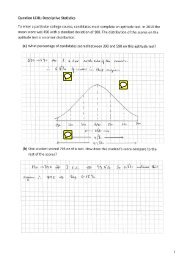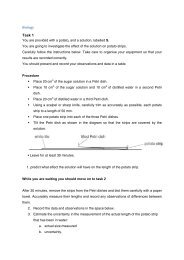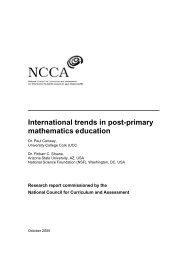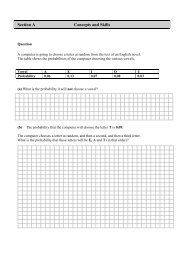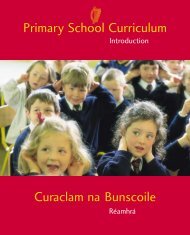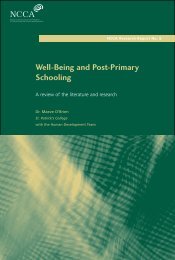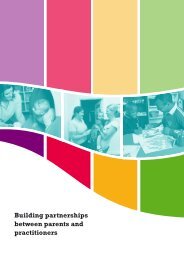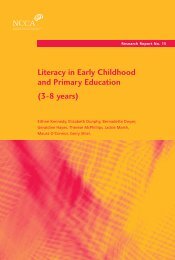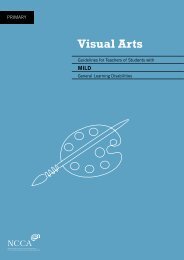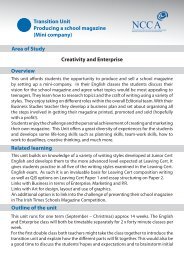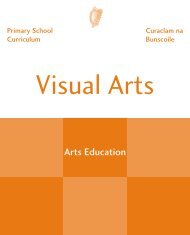Up and Away - National Council for Curriculum and Assessment
Up and Away - National Council for Curriculum and Assessment
Up and Away - National Council for Curriculum and Assessment
You also want an ePaper? Increase the reach of your titles
YUMPU automatically turns print PDFs into web optimized ePapers that Google loves.
Extension<br />
Section 6 Literacy development <strong>for</strong> older pupils<br />
Worksheet A<br />
Put pupils into pairs <strong>and</strong> give only one pupil in each pair a copy of Worksheet A. This creates an<br />
in<strong>for</strong>mation gap <strong>and</strong> pupils must exchange in<strong>for</strong>mation to complete the task:<br />
1. Pupil A reads the sentences on the worksheet to Pupil B.<br />
2. Using the tab cards of names <strong>and</strong> rooms, Pupil B finds the key words <strong>and</strong> fixes them to the rooms in<br />
the pictures.<br />
3. Discarding the worksheet, Pupil A looks at the picture <strong>and</strong> makes sentences which Pupil B writes down.<br />
Worksheets B, C <strong>and</strong> D<br />
After working through Worksheet A, Worksheets B-D can be used in subsequent classes. A suggested<br />
approach <strong>for</strong> each sheet is as follows:<br />
1. Review the activity by asking pupils to label their pictures according to the in<strong>for</strong>mation on Worksheet<br />
A. This can be done individually, in pairs or as a whole class using the A3 picture.<br />
2. H<strong>and</strong> out the selected worksheet*. Pupils answer the questions by referring to the picture.<br />
3. As pupils finish, put them into pairs <strong>and</strong> ask them to check their answers. Pupils can simply compare<br />
or they can ask <strong>and</strong> answer the questions on the worksheet.<br />
*For Worksheets B <strong>and</strong> C, write pupils’ names in the spaces be<strong>for</strong>e making a class set of copies.<br />
The worksheets can also be used to focus on speaking skills:<br />
1. In pairs, Pupil A dictates the questions on one of the worksheets <strong>for</strong> Pupil B to write down.<br />
2. Pupil B reads the questions back to Pupil A who answers them by referring to the picture of the<br />
completed house.<br />
3. They repeat the activity, but switch roles. Ask Pupil B (who is now answering the questions) to move<br />
the names around so that they are in different rooms.<br />
Worksheet E<br />
The approach outlined <strong>for</strong> Worksheet A can be used in exactly the same way <strong>for</strong> Worksheet E <strong>and</strong> Sheet<br />
2 – word tabs to introduce <strong>and</strong> practise household objects.<br />
Worksheets F <strong>and</strong> G<br />
In the same way that Worksheets B-D refer back to Worksheet A (see above), Worksheets F <strong>and</strong> G can be<br />
used in conjunction with Worksheet E.<br />
Working with other themes<br />
The underlying idea of this activity (learning new vocabulary by putting words into the places they are<br />
normally located) can be applied to other Units of Work in the primary curriculum:<br />
Food <strong>and</strong> clothes Put items of food <strong>and</strong> drink in a supermarket trolley, in the fridge/press.<br />
Put items of clothing in the wardrobe/drawers.<br />
People who help us Put people into their places of work on a simple map.<br />
Our school Put people <strong>and</strong> objects into appropriate places in the school.<br />
Seasons, holidays Pack clothes, holiday items in a bag according to the type of holiday/season.<br />
<strong>and</strong> festivals<br />
Animals <strong>and</strong> plants Categorise animals – e.g. pets, farm <strong>and</strong> wild.<br />
217



